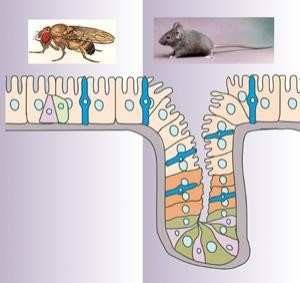Drosophila as a model to study local and extrinsic regulation of stem cell function in the intestine – Dr Julia Cordero

Homeostasis, the process through which a tissue maintains its’ optimal functional conditions, is a tightly regulated process. This regulation is achieved through the careful control of cell turnover within the tissue, removing damaged cells through the induction of apoptosis and encouraging cell proliferation to generate new cells to replenish the tissue. Stem cells therefore play an essential role in maintaining the balanced ratio of cell types, proliferating in response to damage. However, the means through which stem cells receive and send signals to coordinate this, remain somewhat elusive.
Such was the topic of this week’s external seminar at the IGMM, given by Dr. Julia Cordero [1] who joined us from the Institute of Cancer Science at the University of Glasgow. Julia is currently a Wellcome Trust/Royal Society Sir Henry Dale Fellow and was recently awarded a CRUK Pioneer Award. Her lab combines Drosophila melanogaster and mouse models to study tissue homeostasis within the intestine, a tissue which is constantly exposed to potential damage causing agents.

Figure 1 Comparison of the Drosophila mid gut with the mouse small intestine Source:https://www.gla.ac.uk/researchinstitutes/cancersciences/staff/juliacordero/#/researchinterests
This combinatorial approach; using Drosophila as a discovery model and confirming their results using mouse models, is something not many other labs are doing and Julia’s talk highlights the power of doing so. Commenting on the benefits of using the two models in combination, Julia says that in translating their findings from Drosophila to mouse, they find overlap more often than not, owing to the many similarities between the adult Drosophila mid gut and the small intestine of the mouse.
Using this combinatorial approach, Julia’s lab have been successful in investigating stem cell function in homeostasis in the adult Drosophila midgut. Discussing one particularly exciting aspect of this, Julia presented work her lab has recently conducted revealing a novel role for a member of the piRNA (PIWI-interacting RNA) pathway – Aubergine.
RNAseq of intestinal tissue before and during an induced regeneration response (elicited through feeding pathogenic bacteria to adult Drosophila) revealed up-regulation of certain elements involved in the piRNA pathway; PIWI, Argonaute (Ago) and Aubergine (Aub).
Selective knockouts of these components, and subsequent cell proliferation assays, revealed an inability of the tissue to regenerate in response to damage upon knockout of the gene encoding Aubergine, with minimal impact on regeneration seen with knockdown of other components.
Further investigation by Julia’s team indicated the role of Aub expression in tissue regeneration to be related to WNT signalling, as it is needed for up-regulation of wingless (wg). Suggesting that Aub expression in stem cells may act indirectly to regulate stem cell function during tissue regeneration.
Although the link between regeneration and Aub expression was clearly demonstrated here, it was not demonstrated whether this new role for Aub is completely independent of its’ function within the piRNA pathway or not, something I hope Julia’s group can address in future work.
Julia’s team also identified a role for tracheal remodelling in regulating stem cell proliferation in response to damage. Again using the Drosophila mid gut as their model system, a time course showed sprouting of trachael terminal cells (TTCs) in the intestinal stem cell (ISC) micro-environment in correlation with stem cell proliferation.
Tracheal remodelling persisted in flies genetically manipulated to prevent ISC proliferation revealing TTC sprouting to be an upstream event. TTCs have the capacity to sprout in response to hypoxia, branching out to oxygen-starved areas [2], and so it is possible that an hypoxia-like response is responsible for the involvement of tracheal remodelling in stem cell proliferation in response to intestinal damage.
Multiple signals appear to be necessary for ISC proliferation to occur in response to damage, with these coming both from the stem cells themselves as well as cells in their micro-environment, and there remains many questions regarding the order of events required in the regeneration response.
I found this week’s seminar thought-provoking not only in revealing mechanisms underpinning the role of stem cells in the regulation of homeostasis but also in promoting a different approach to answering these fundamental questions through the techniques being used in the Cordero lab. In particular, I think Julia’s work illustrates the power of using a relatively simple model to study what is an inherently complex process. Working mainly on Drosophila, with the use of a mouse model for confirmation experiments only, highlights the potential for non-mammalian models to be relied upon as a tool for discovery, something the National Centre for the Replacement, Refinement and Reduction of Animals in Research (NC3Rs)[3] heavily supports, and which remains a topic of immense importance.
References and Further Reading
- https://www.gla.ac.uk/researchinstitutes/cancersciences/staff/juliacordero/
- Dev Cell.2008 Apr;14(4):547-58. doi: 10.1016/j.devcel.2008.01.020. https://www.ncbi.nlm.nih.gov/pubmed/1841073
- https://www.nc3rs.org.uk/
- Scopelliti et al., 2019, Cell Metabolism 29, 269–284 February 5, 2019 ª 2018 The Author(s). Published by Elsevier Inc.https://doi.org/10.1016/j.cmet.2018.09.021



